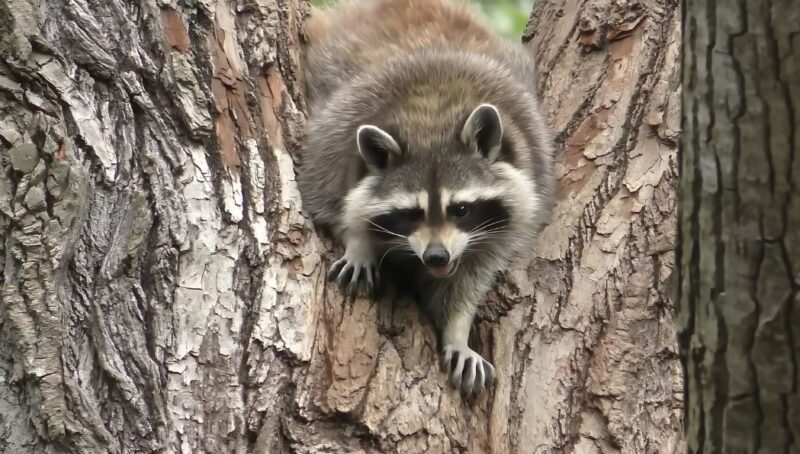Raccoons, with their characteristic bandit-mask faces and ringed tails, are among the most recognizable mammals in North America. While they are often seen rummaging through urban garbage cans, they also thrive in a variety of habitats, including forests, mountains, and marshes.
An intriguing aspect of raccoons is their sensory capabilities, which play a crucial role in their survival and adaptability. This article delves into the sensory world of raccoons, exploring how their senses contribute to their remarkable ability to navigate and thrive in diverse environments.
Sensory Overview
Raccoons are equipped with a complex set of senses that include sight, hearing, smell, and an extraordinary sense of touch. Each of these senses is fine-tuned to help raccoons in their daily activities like foraging, avoiding predators, and social interactions. Unlike humans, who primarily rely on sight and sound, raccoons have a more balanced sensory profile, with a particular emphasis on touch.
| Sense | Function in Raccoons | Comparison with Humans |
|---|---|---|
| Sight | – Foraging
– Avoiding predators |
Less reliant than humans |
| Hearing | – Foraging
– Avoiding predators – Social interactions |
Balanced, similar reliance |
| Smell | – Foraging
– Social interactions |
Balanced, similar reliance |
| Touch | – Foraging
– Social interactions -Emphasized in daily activities |
More emphasized in raccoons |
Vision

The eyes of a raccoon are highly adapted for nocturnal life. Their large pupils allow more light to enter, enhancing their ability to see in the dark. The retina of a raccoon’s eye is rich in rod cells, which are more sensitive to light than cone cells responsible for color vision. This adaptation means that while their color vision is limited, especially in low light conditions, their ability to detect movement and navigate in the dark is exceptional.
Raccoons also have a reflective layer behind the retina, known as the tapetum lucidum. This layer reflects light back through the retina, increasing the light available to the photoreceptors. This is why raccoon eyes often appear to glow in the dark when light shines on them. This adaptation is particularly beneficial when foraging at night or moving through dense forests with little light.
Auditory Acuity

Raccoons have a well-developed sense of hearing, which is crucial for detecting prey and avoiding predators. Their ears are sharp and can rotate independently, allowing them to pinpoint the origin of sounds with remarkable accuracy. This ability is particularly important in dense vegetation where visibility is limited.
Raccoons use their hearing not only for survival but also for communication. They have a wide range of vocalizations, including growls, hisses, whistles, and screams. These sounds are used to convey different messages, such as warnings, mating calls, or expressions of pain. Mother raccoons also communicate with their kits using specific sounds.
Olfactory Capabilities

The sense of smell in raccoons is highly developed and is integral to their survival. Raccoons use their keen sense of smell to locate food, identify other animals, and sense danger. Their olfactory sensitivity is particularly useful when foraging, as they can detect food items buried under leaves, soil, or snow.
In addition to foraging, smell plays a crucial role in social interactions among raccoons. Scent marking is a common behavior used to establish territory, attract mates, or communicate status. Raccoons have scent glands located on various parts of their bodies, including the face, paws, and base of the tail, which they use to leave olfactory messages in their environment.
The Mastery of Touch

Perhaps the most remarkable of the raccoon’s senses is their sense of touch, especially in their front paws. Raccoons have highly sensitive paws with a high concentration of tactile receptors. This sensitivity is enhanced when their paws are wet, which is why raccoons are often observed ‘washing’ their food in water. This behavior is not actually washing but rather a way to gather more sensory information about the object they are handling.
The dexterity of raccoon paws is akin to that of primates, including humans. They can manipulate objects with great precision, which aids in foraging, especially when extracting food from narrow spaces or shells. This dexterity is also useful in navigating their environment, climbing, and even opening containers or doors.
Spatial Awareness and Navigation

Raccoons possess an impressive sense of spatial awareness, which is essential for their survival in both wild and urban environments. They are known to travel extensive distances in search of food or mates, often retracing their steps over several nights. This ability suggests a strong memory and spatial mapping capabilities.
In urban areas, raccoons have demonstrated an uncanny ability to navigate complex environments, such as crossing roads, navigating fences, and avoiding human interaction. This adaptability is a testament to their sensory acuity and cognitive abilities, allowing them to thrive in environments that are drastically different from their natural habitats.
FAQs
Final Words
Raccoons’ sensory abilities are a striking example of evolutionary adaptation, showcasing how a species can evolve to master its environment. Their success in both rural and urban settings highlights the importance of sensory versatility in the animal kingdom.
As we continue to observe and study these fascinating creatures, their sensory world offers a window into the intricate balance of nature and the ongoing dance of adaptation and survival.
Related Posts:
- Where to Find Raccoons in the Forest? Wildlife Encounters
- What Sounds Do Raccoons Make? - Meaning and How to…
- How To Stop Raccoons Digging Up Your Lawn -…
- What Do Raccoons Eat? - How Their Diets Overlap and Differ
- How Good Is a Black Bear’s Sense of Smell? Into the…
- Do Beavers Make Good Pets? What You Need to Know…








